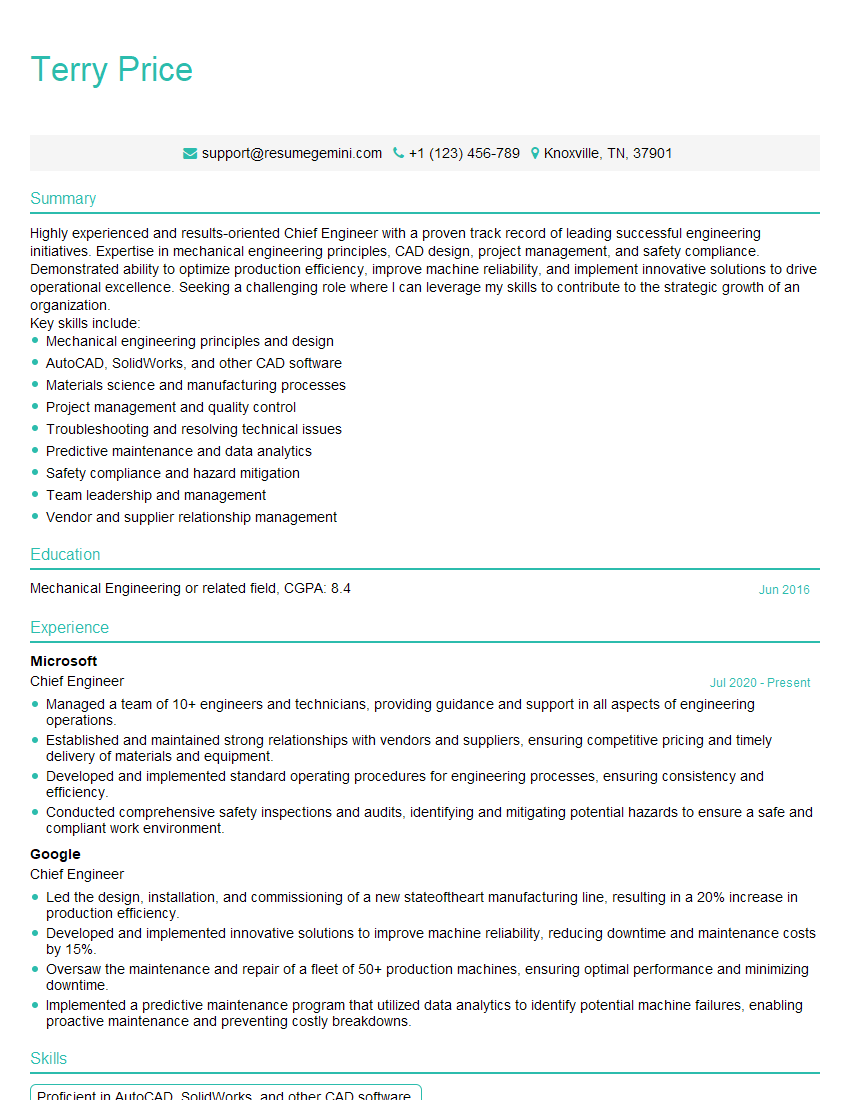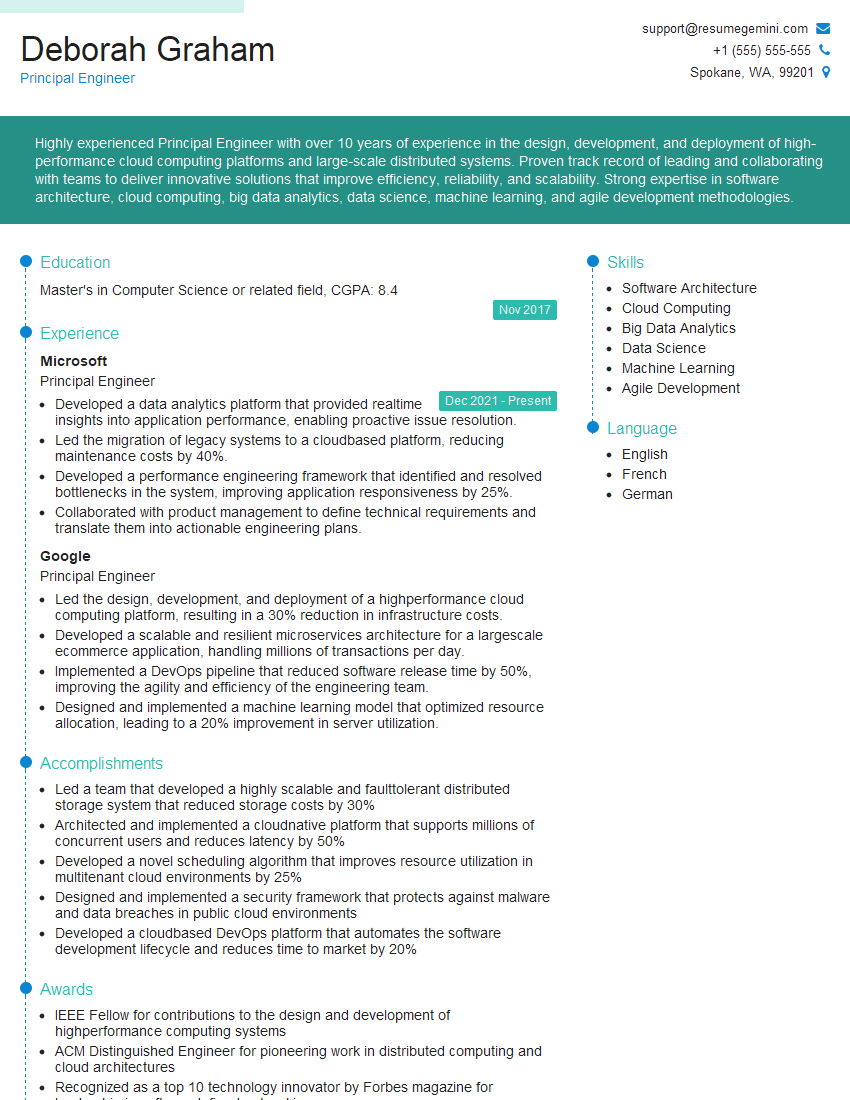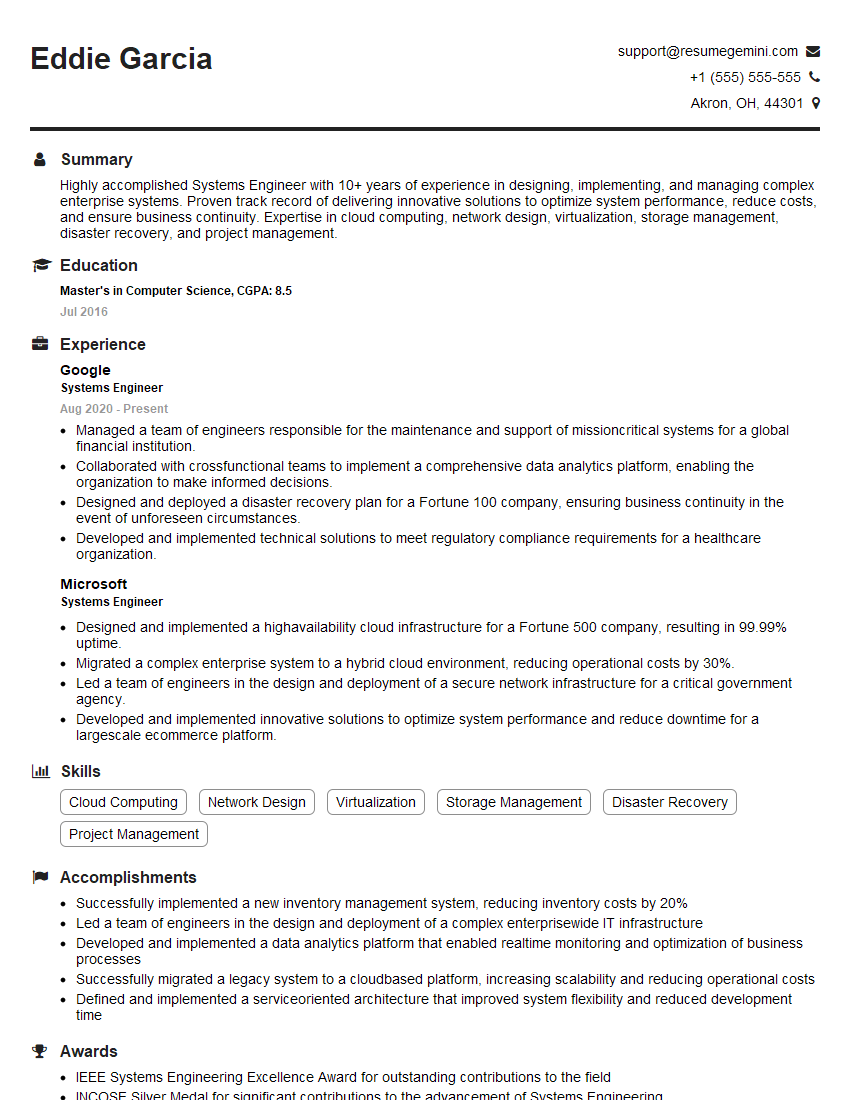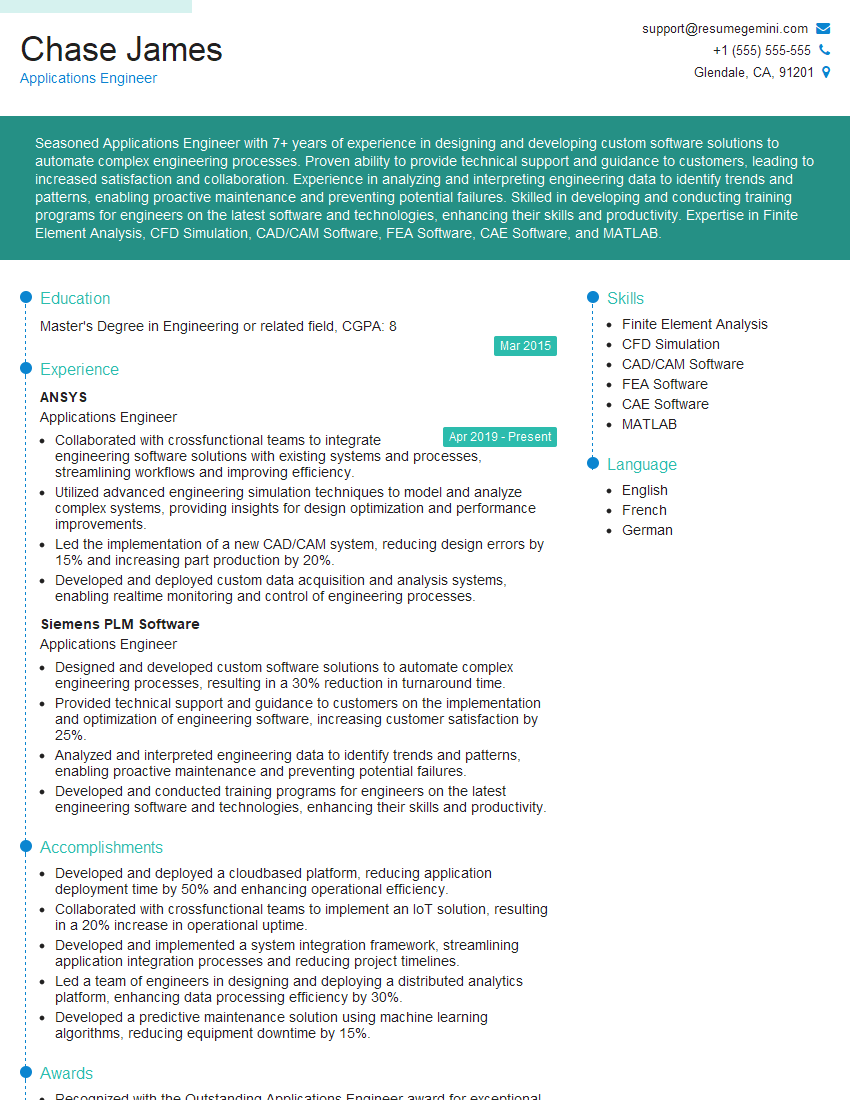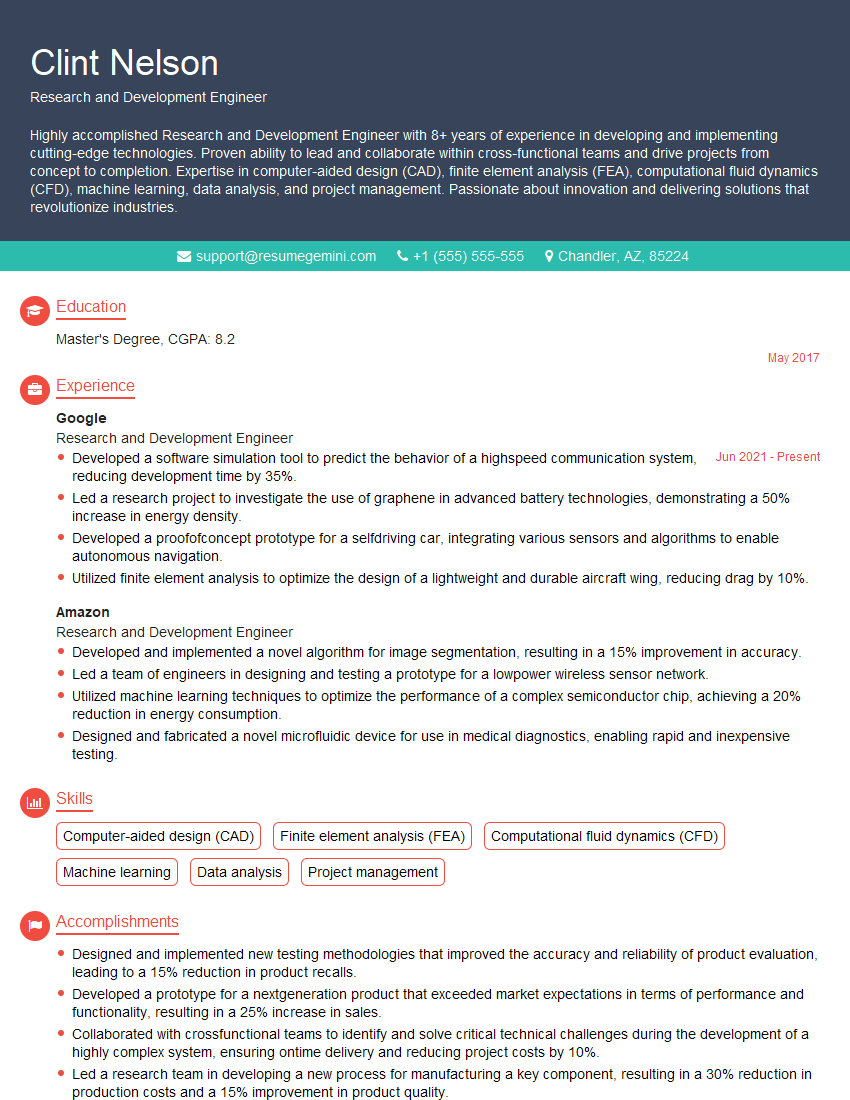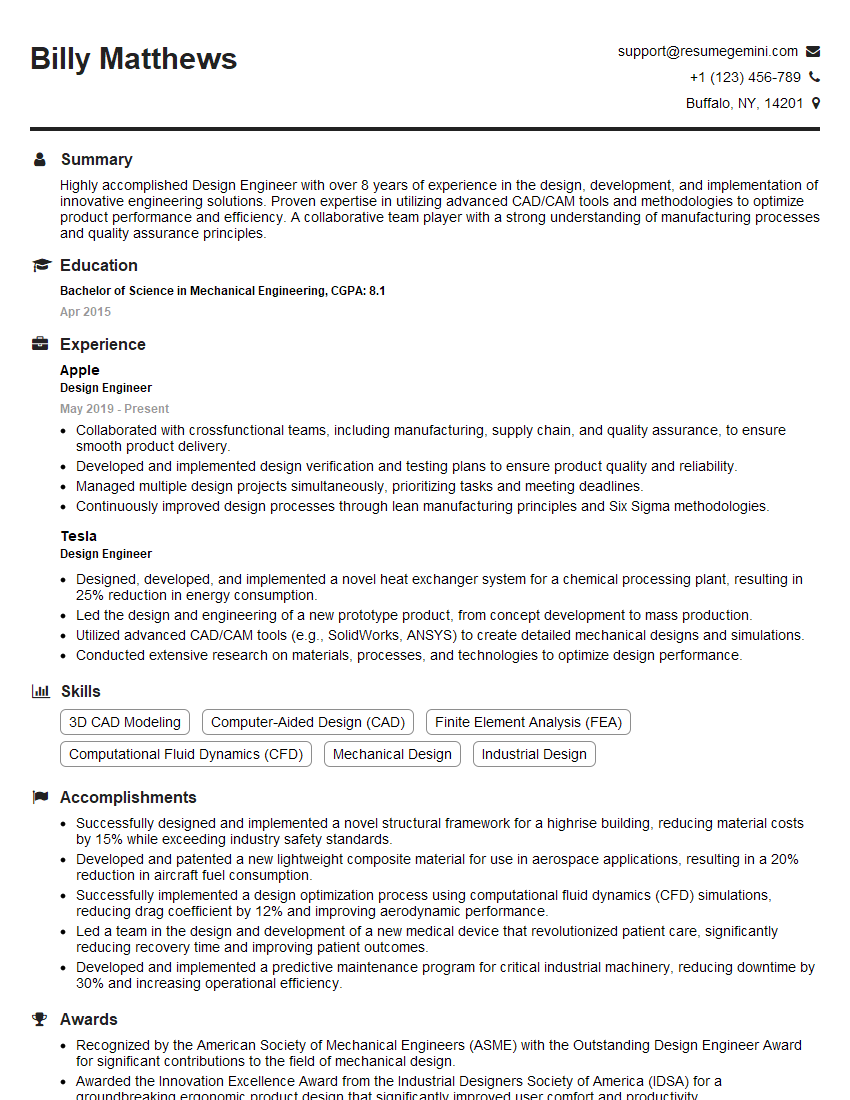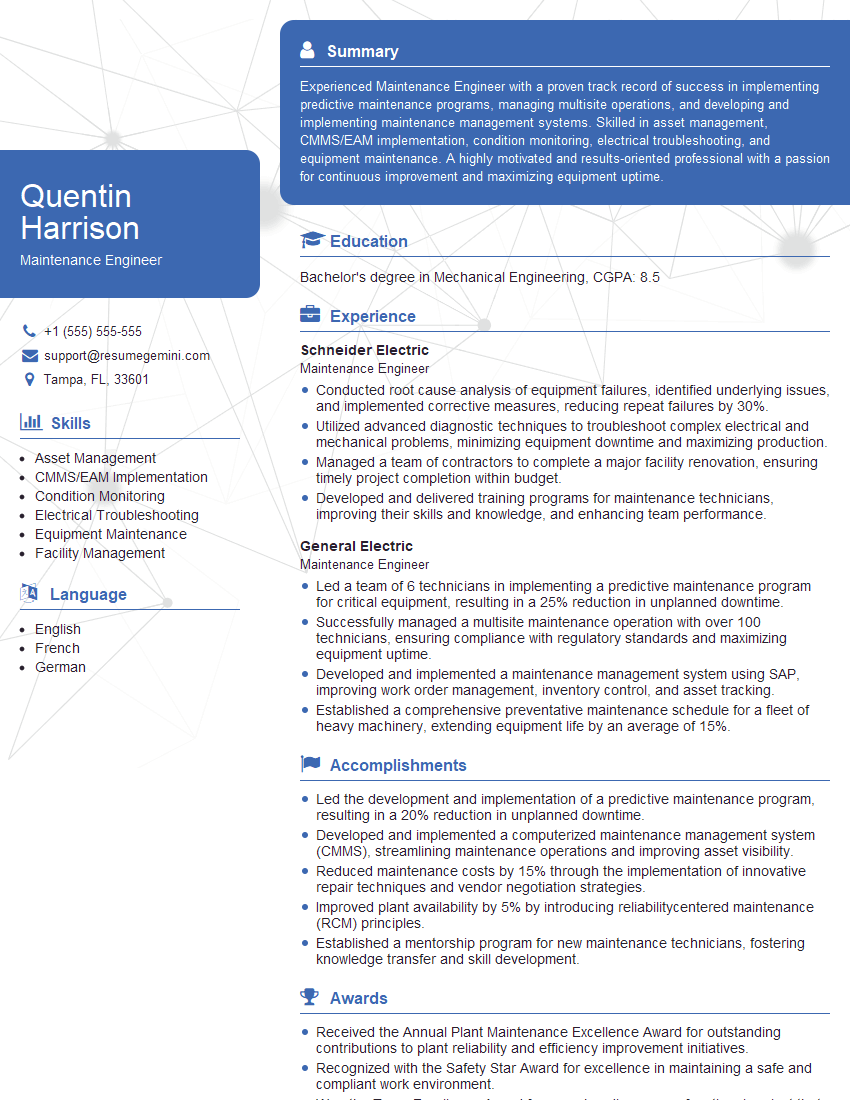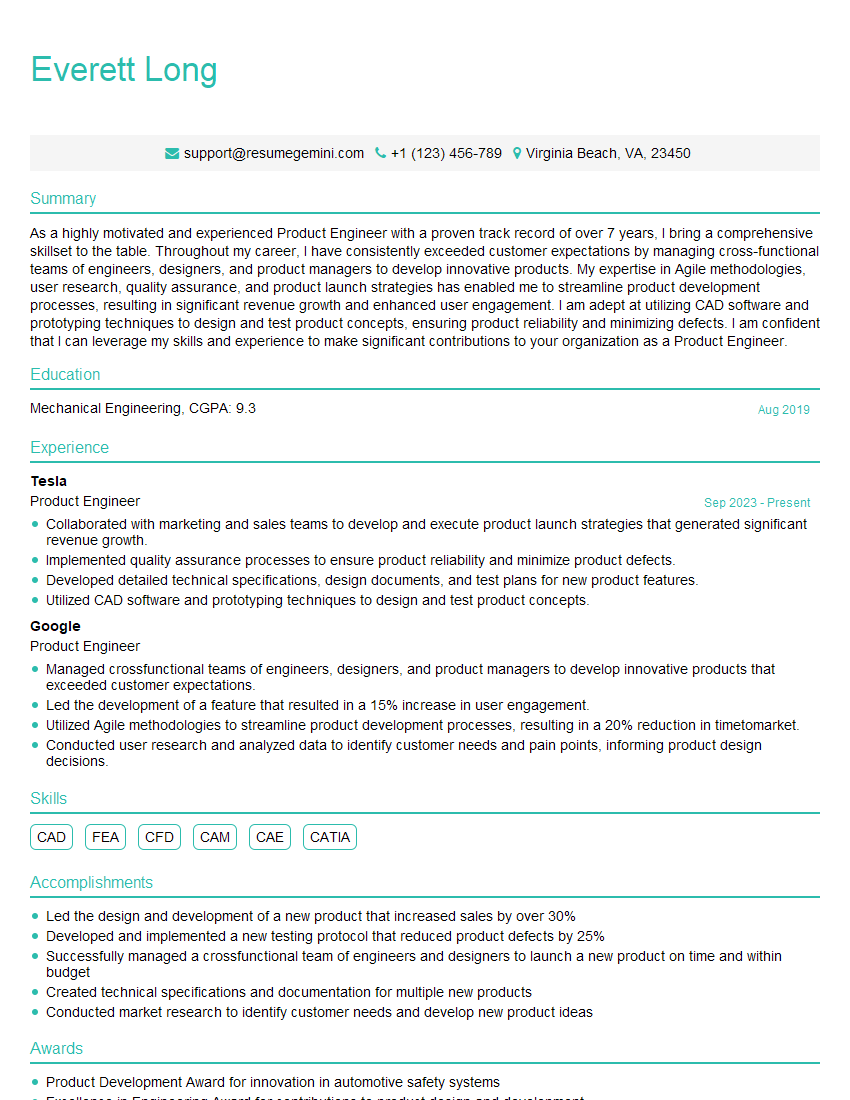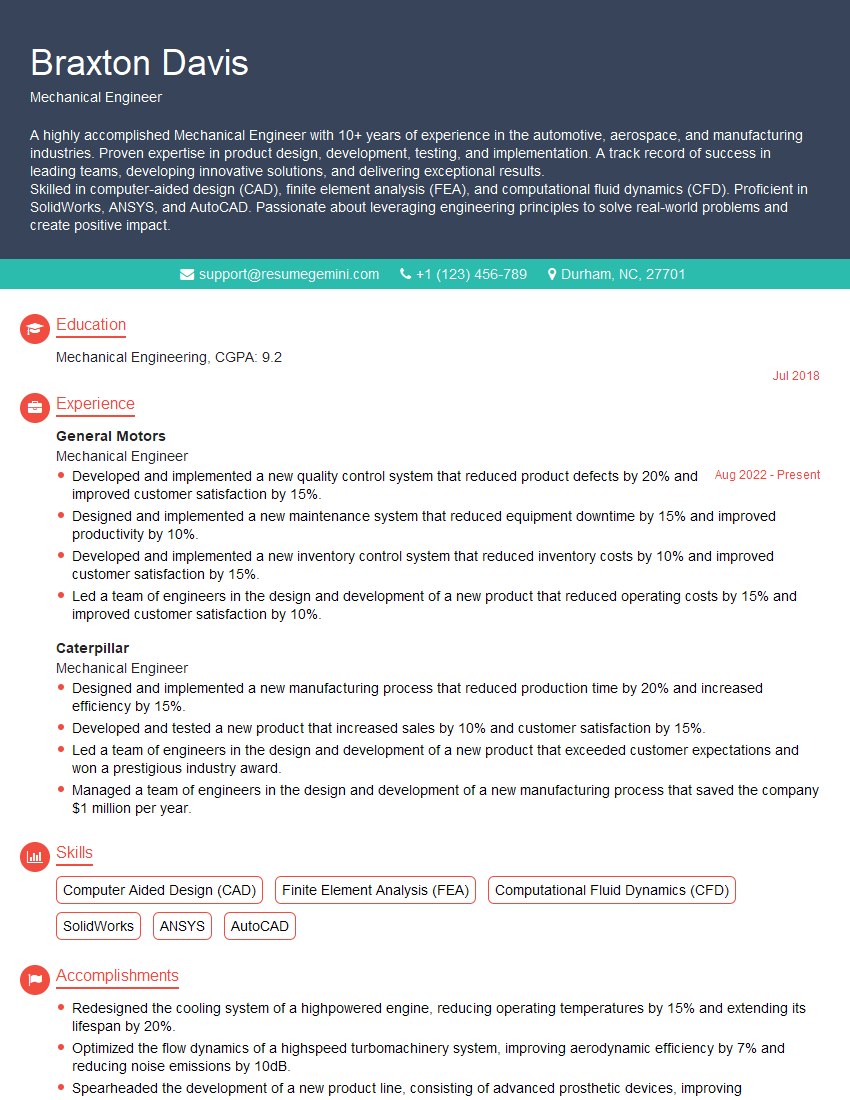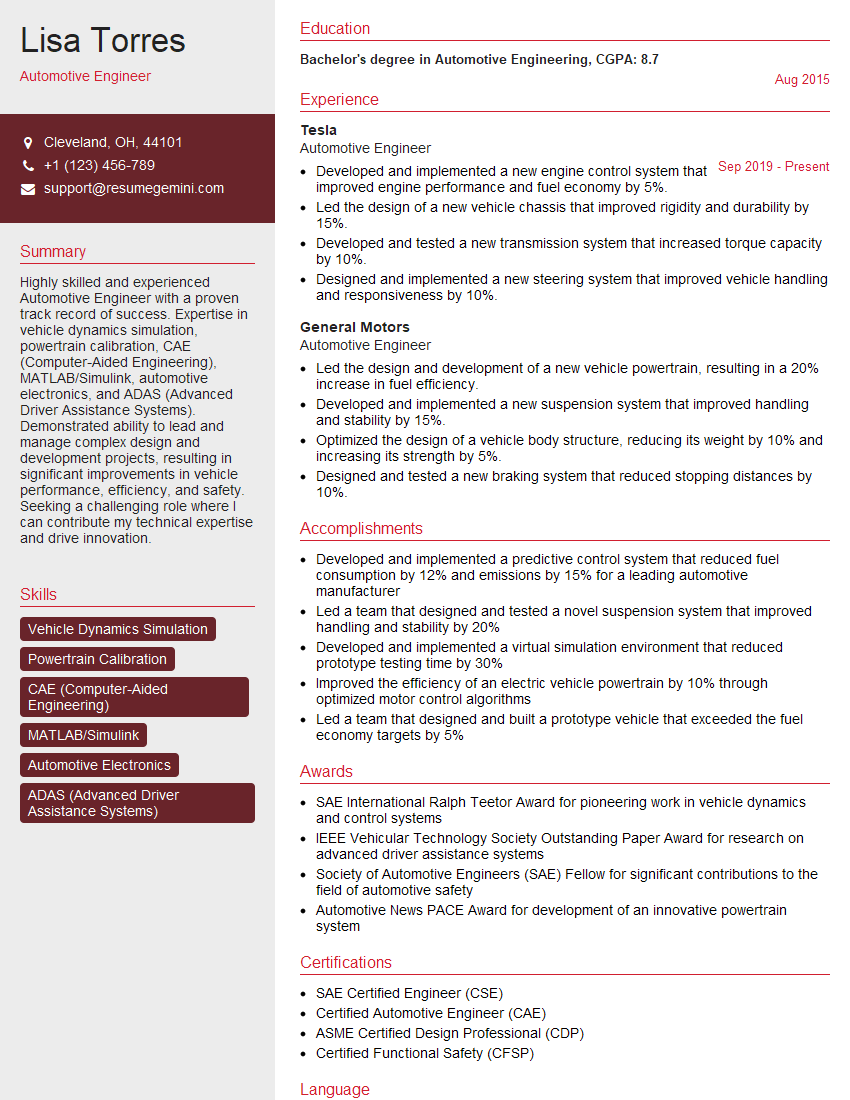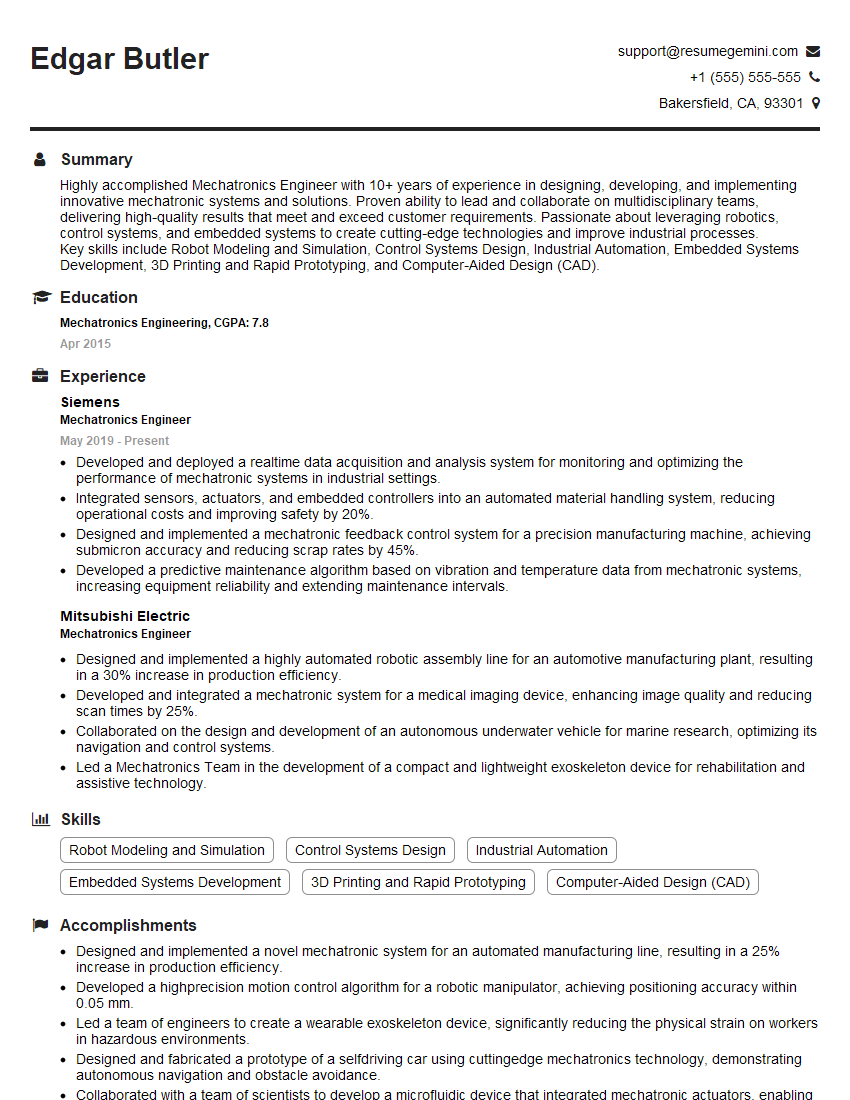Preparation is the key to success in any interview. In this post, we’ll explore crucial Mechanical Systems Knowledge interview questions and equip you with strategies to craft impactful answers. Whether you’re a beginner or a pro, these tips will elevate your preparation.
Questions Asked in Mechanical Systems Knowledge Interview
Q 1. Explain the different types of mechanical stresses and strains.
Mechanical stress and strain are fundamental concepts in mechanics. Stress represents the internal forces within a material caused by external loads, measured in Pascals (Pa) or other pressure units. Strain describes the material’s deformation in response to these stresses, representing the change in length or shape relative to the original dimensions. It’s a dimensionless quantity.
Types of Stress:
- Tensile Stress: Occurs when a material is pulled apart, stretching it. Think of pulling a rubber band.
- Compressive Stress: Occurs when a material is squeezed together. Imagine stacking books on top of each other.
- Shear Stress: Occurs when parallel forces act in opposite directions, causing a sliding motion within the material. A good example is cutting with scissors.
- Bending Stress: A combination of tensile and compressive stress, observed when a beam is subjected to a load. Think of a diving board.
- Torsional Stress: Occurs when a twisting force acts on a material, like turning a screwdriver.
Types of Strain:
- Tensile Strain: The elongation of a material under tensile stress.
- Compressive Strain: The shortening of a material under compressive stress.
- Shear Strain: The change in angle between two initially perpendicular lines within a material under shear stress.
Understanding the different types of stress and strain is crucial for designing structures and components that can withstand various loads and operating conditions, preventing failure.
Q 2. Describe your experience with Finite Element Analysis (FEA).
I have extensive experience using Finite Element Analysis (FEA) software, primarily ANSYS and Abaqus. My work has involved a wide range of applications, from simulating the structural integrity of automotive components to analyzing the thermal performance of heat exchangers. In one project, I used FEA to optimize the design of a complex robotic arm, reducing its weight by 15% while maintaining its structural stiffness. This involved creating a detailed finite element model, defining material properties, applying boundary conditions (like forces and constraints), and running simulations to predict stress, strain, and displacement under various load cases. The results helped us identify stress concentrations and refine the design for improved performance and reliability. I’m proficient in meshing techniques, result interpretation, and validating FEA results against experimental data or analytical solutions. Furthermore, I’m familiar with different element types and their applications, ensuring the selection of appropriate elements for accurate simulation results.
Q 3. How would you approach designing a more efficient heat exchanger?
Designing a more efficient heat exchanger involves several key strategies. The core principle is to maximize the heat transfer rate while minimizing the size and pressure drop.
My approach would be multi-faceted:
- Enhance Surface Area: Using extended surfaces like fins increases the contact area between the hot and cold fluids, significantly boosting heat transfer. The design of these fins needs optimization, considering the tradeoff between surface area and pressure drop.
- Optimize Fluid Flow: Turbulent flow enhances heat transfer compared to laminar flow. Designing channels or using turbulence promoters can increase the effectiveness of the heat exchanger. Computational Fluid Dynamics (CFD) simulations are invaluable here.
- Improve Material Selection: Materials with high thermal conductivity, like copper or aluminum, minimize thermal resistance. The selection also depends on factors such as corrosion resistance and cost.
- Consider Fouling: The build-up of deposits on heat exchanger surfaces (fouling) reduces efficiency. Designing for easy cleaning or using materials resistant to fouling is crucial for long-term performance.
In practice, I would use a combination of analytical calculations, CFD simulations, and experimental testing to refine the design and achieve optimal performance. The iterative process would involve comparing different designs based on parameters like effectiveness, pressure drop, and overall size. This ensures the final design meets the specified requirements and is cost-effective.
Q 4. What are the key considerations for selecting a suitable bearing for a specific application?
Bearing selection is critical for the longevity and smooth operation of any rotating machinery. The choice depends heavily on several key factors:
- Load Type and Magnitude: Radial loads (perpendicular to the shaft), thrust loads (axial), or combined loads influence the bearing type. High loads demand bearings with high load-carrying capacity.
- Speed of Rotation: High-speed applications require bearings with low friction and high rotational speeds. Conversely, lower speeds permit the use of simpler, less expensive bearings.
- Operating Environment: Temperature, humidity, presence of contaminants (dust, chemicals), and lubrication conditions strongly impact bearing material and sealing requirements. For example, food processing equipment might require stainless steel bearings.
- Precision and Accuracy: Applications demanding high precision, like robotic arms, necessitate bearings with tight tolerances and minimal runout.
- Cost and Maintainability: Cost considerations often play a role, weighing the initial cost against maintenance needs. Some bearings require frequent lubrication or replacement compared to others (like self-lubricating bearings).
For instance, a high-speed application with radial load would benefit from a high-precision angular contact ball bearing. In contrast, a low-speed application with heavy axial load might utilize a thrust ball bearing. A thorough understanding of the application’s requirements is fundamental for the right choice.
Q 5. Explain the principles of thermodynamics relevant to mechanical systems.
Thermodynamics plays a vital role in understanding and optimizing mechanical systems. Key principles relevant to mechanical systems include:
- First Law of Thermodynamics (Conservation of Energy): The total energy of a closed system remains constant; energy cannot be created or destroyed, only transformed. This is fundamental to energy analysis in systems such as internal combustion engines, where chemical energy is converted into mechanical energy.
- Second Law of Thermodynamics (Entropy): Natural processes tend to proceed in a direction that increases the total entropy (disorder) of the universe. This law governs the efficiency of heat engines and refrigerators, placing limits on how much useful work can be extracted from heat. For instance, the Carnot efficiency provides an upper bound on the efficiency of a heat engine.
- Thermodynamic Cycles: These are sequences of thermodynamic processes that form a closed loop, often used to model engine cycles (e.g., Otto, Diesel, Rankine) and refrigeration cycles (e.g., Vapor-Compression). Understanding these cycles enables performance optimization.
- Heat Transfer: Mechanisms of heat transfer (conduction, convection, radiation) are critical to designing efficient cooling systems, heat exchangers, and managing thermal stresses in mechanical components.
Applying thermodynamic principles allows for optimizing energy efficiency, predicting performance, and designing systems that operate within safe temperature limits.
Q 6. Describe your experience with CAD software (e.g., SolidWorks, AutoCAD).
I’m highly proficient in several CAD software packages, including SolidWorks, AutoCAD, and Inventor. My experience encompasses creating 2D and 3D models of mechanical components and assemblies, generating detailed engineering drawings, and performing simulations. For example, in a recent project involving the design of a new type of pump, I used SolidWorks to model the pump’s internal components, perform kinematic analysis to simulate its motion, and conduct Finite Element Analysis (FEA) to ensure its structural integrity under operating conditions. The generated 3D model and detailed drawings were crucial for manufacturing and assembly. I’m comfortable working with parametric modeling, assembly constraints, and creating detailed technical documentation.
Q 7. How do you ensure the safety and reliability of mechanical systems?
Ensuring the safety and reliability of mechanical systems is paramount. My approach is a multi-layered one:
- Design for Safety: Incorporating safety features from the initial design phase. This includes considering potential failure modes, implementing redundancies, and choosing appropriate safety factors in calculations.
- Material Selection: Using materials with appropriate strength, durability, and resistance to corrosion or fatigue. Material selection is crucial to avoid catastrophic failures.
- Manufacturing Processes: Selecting and monitoring manufacturing processes to ensure dimensional accuracy, surface finish, and material integrity. Quality control is essential here.
- Testing and Validation: Conducting thorough testing, including prototype testing, simulations (like FEA), and fatigue analysis, to validate design assumptions and identify potential weaknesses. This might include destructive testing to evaluate material properties.
- Maintenance and Inspection: Establishing a comprehensive maintenance and inspection schedule to detect and address potential problems before they escalate into failures. Preventative maintenance can significantly improve reliability and safety.
- Adherence to Standards and Regulations: Complying with relevant safety standards (e.g., ASME, ISO) and industry regulations is crucial to ensure the system meets required safety and performance levels.
Ultimately, a proactive approach to safety and reliability, integrating these measures throughout the design, manufacturing, and operational life cycle of the mechanical system, is essential.
Q 8. What are your experiences with failure analysis and root cause identification?
Failure analysis is a systematic process of identifying the root cause of a mechanical system’s malfunction. It’s like being a detective for machines! My experience involves using a combination of techniques, starting with a thorough examination of the failed component. This includes visual inspection for cracks, wear, or deformation. I then utilize various analytical tools depending on the situation. For instance, I might employ material testing (e.g., tensile testing, hardness testing) to determine if material degradation played a role. Sometimes, finite element analysis (FEA) simulations are crucial to understand stress distributions and identify potential weak points. Finally, I document my findings comprehensively, often creating detailed reports with photos, diagrams, and analytical data, which includes proposing corrective actions to prevent recurrence.
For example, I once investigated a recurring failure in a high-speed centrifugal pump. Initial inspection revealed pitting on the impeller blades. Through material analysis, we discovered that cavitation was the culprit, leading to material erosion. FEA simulations helped us optimize the impeller design, reducing the cavitation effect and resolving the recurring failures.
Q 9. Explain different types of gears and their applications.
Gears are fundamental mechanical components used to transmit power and torque between rotating shafts. Different gear types are optimized for specific applications based on factors like speed ratio, torque capacity, and efficiency.
- Spur gears: These have straight teeth parallel to the axis of rotation, simple to manufacture but can be noisy at high speeds.
- Helical gears: These have angled teeth, offering smoother operation and higher load-carrying capacity compared to spur gears. They are quieter and more efficient but more complex to manufacture.
- Bevel gears: Used to transmit power between intersecting shafts. These are crucial in applications where shafts meet at angles, such as in automotive differential systems.
- Worm gears: Consisting of a worm (screw-like gear) and a worm wheel, these are ideal for high gear ratios and self-locking capabilities, often found in jacks and hoists.
- Rack and pinion gears: A linear motion is converted into rotary motion and vice-versa. Used in steering mechanisms and linear actuators.
For instance, spur gears are common in simple applications like hand drills, while helical gears are preferred in high-performance gearboxes like those found in automobiles and industrial machinery. Bevel gears are essential in automotive differential systems, allowing the wheels to rotate at different speeds during turns. Worm gears provide high reduction ratios in applications requiring precise speed control and self-locking functionality. Rack and pinion gears are crucial in applications needing linear-rotary motion conversion.
Q 10. Describe your experience with manufacturing processes like machining and casting.
My experience encompasses a wide range of manufacturing processes, primarily focusing on machining and casting. Machining involves removing material from a workpiece to create a desired shape and size. Common machining operations include milling, turning, drilling, and grinding. I’ve worked extensively with CNC (Computer Numerical Control) machines, programming and operating them to produce complex parts with high precision and repeatability. Casting, on the other hand, involves pouring molten material into a mold, allowing it to solidify, and then removing the resulting part. I have experience with different casting methods, including sand casting, die casting, and investment casting, each with its own advantages and limitations regarding material properties, part complexity, and production volume.
For example, I oversaw the manufacture of a complex pump housing. We used investment casting for high precision and intricate geometries, followed by machining operations to achieve the final tolerances and surface finish. This process involved close collaboration with manufacturing engineers to optimize the design for manufacturability and cost-effectiveness.
Q 11. How would you troubleshoot a malfunctioning mechanical system?
Troubleshooting a malfunctioning mechanical system requires a systematic approach. Think of it as a methodical investigation. I typically start with a thorough inspection, checking for obvious issues like loose connections, broken parts, or leaks. Then, I gather data by examining sensor readings, analyzing logs, and conducting functional tests. This data helps me pinpoint the area of the malfunction. Depending on the system’s complexity, I may use diagnostic tools like vibration analyzers, infrared cameras, or specialized software.
Once the problem area is identified, I employ a process of elimination, systematically testing components and subsystems to isolate the root cause. This often involves replacing suspect parts, adjusting settings, or running simulations. Finally, I implement the solution, verify its effectiveness, and document the entire troubleshooting process for future reference. A crucial part is to understand the system’s design and functionality, which is why thorough documentation is vital.
Q 12. Explain the concept of vibration analysis and its importance.
Vibration analysis is the process of measuring and interpreting vibrations in mechanical systems. It’s like listening to the machine’s heartbeat to diagnose potential problems. Vibrations can indicate imbalances, misalignments, wear, or impending failures. By analyzing vibration signals (frequency, amplitude, phase), we can identify the source and severity of the problem, often before it leads to catastrophic failure.
The importance of vibration analysis lies in its ability for early detection of faults. For instance, a slight imbalance in a rotating machine may initially cause minor vibrations, but if left unchecked, it can lead to bearing damage and eventual failure. By monitoring vibrations regularly and analyzing the data, we can schedule maintenance proactively, avoiding costly downtime and potential safety hazards. Different techniques like FFT (Fast Fourier Transform) are employed to analyze the frequency components of the vibration signals, identifying characteristic frequencies associated with specific machine faults.
Q 13. Describe your experience with control systems and actuators.
My experience with control systems and actuators encompasses the design, implementation, and testing of systems that regulate and control the motion and position of mechanical components. Actuators are the muscle of the system, converting electrical, hydraulic, or pneumatic energy into mechanical motion. I’ve worked with various types of actuators, including electric motors (DC, AC servo, stepper motors), hydraulic cylinders, and pneumatic actuators. Control systems use sensors to monitor the system’s state and use algorithms to control the actuator, achieving desired performance.
For example, I was involved in developing a closed-loop control system for a robotic arm. This involved selecting appropriate actuators, designing the control algorithm (PID controller), integrating sensors (position encoders), and testing the system’s performance. Ensuring precise and responsive control while maintaining stability is key.
Q 14. How do you handle design changes and project revisions?
Handling design changes and project revisions requires flexibility, communication, and a systematic approach. The first step is to thoroughly understand the reason for the change. Is it due to a design flaw, a new requirement, or a change in the project scope? Once the reason is clear, I carefully assess the impact of the change on the overall design, schedule, and budget. This often involves collaborating with other engineers, including designers, manufacturing engineers, and project managers. I would then develop a revised design, ensuring that it meets all the requirements and specifications, while adhering to best practices and standards.
It is crucial to document all changes meticulously, updating designs, specifications, and test procedures accordingly. The implementation phase demands rigorous testing to verify that the revised design functions as intended and maintains its integrity. Open communication with stakeholders throughout the entire process is essential to manage expectations and ensure a smooth transition.
Q 15. What are the principles of fluid mechanics relevant to your work?
Fluid mechanics principles are fundamental to many mechanical systems. My work frequently involves applying concepts like fluid statics (pressure, buoyancy), fluid dynamics (flow rate, viscosity, Bernoulli’s principle), and compressible flow (for applications involving gases).
- Example 1: Designing a hydraulic system for a construction vehicle requires understanding Pascal’s law to distribute force effectively and selecting appropriate pipe diameters based on flow rate calculations to minimize energy loss.
- Example 2: Analyzing the aerodynamic performance of a vehicle necessitates applying concepts of boundary layers, drag, and lift, often using computational fluid dynamics (CFD) software to simulate airflow and optimize the design for reduced drag and improved fuel efficiency.
- Example 3: In designing a cooling system for an engine, I use principles of heat transfer involving convective heat transfer from the engine components to the coolant fluid, which is then used to dissipate heat through a radiator.
Career Expert Tips:
- Ace those interviews! Prepare effectively by reviewing the Top 50 Most Common Interview Questions on ResumeGemini.
- Navigate your job search with confidence! Explore a wide range of Career Tips on ResumeGemini. Learn about common challenges and recommendations to overcome them.
- Craft the perfect resume! Master the Art of Resume Writing with ResumeGemini’s guide. Showcase your unique qualifications and achievements effectively.
- Don’t miss out on holiday savings! Build your dream resume with ResumeGemini’s ATS optimized templates.
Q 16. Explain your experience with material selection for mechanical components.
Material selection is critical for ensuring component reliability, durability, and cost-effectiveness. My process involves considering factors like strength, stiffness, weight, corrosion resistance, temperature tolerance, and manufacturing feasibility. I utilize material property databases and software tools to compare alternatives.
- Example 1: In a high-stress application like a crankshaft, I would choose a high-strength steel alloy for its ability to withstand significant fatigue loads. The specific alloy will depend on factors such as cost and required fatigue life.
- Example 2: For a lightweight component in an aerospace application, I might select a composite material like carbon fiber reinforced polymer (CFRP) to minimize weight while maintaining sufficient strength and stiffness.
- Example 3: In a corrosive environment, I would opt for materials like stainless steel or specialized polymers to prevent degradation.
I always consider the entire lifecycle of the material, factoring in sustainability and recyclability.
Q 17. How do you ensure the manufacturability of your designs?
Ensuring manufacturability is paramount. I integrate manufacturing considerations throughout the design process, employing techniques like Design for Manufacturing (DFM) and Design for Assembly (DFA).
- DFM: This involves selecting manufacturing processes (e.g., casting, machining, forging) appropriate for the chosen materials and design complexity. I also consider factors like tolerances, surface finish requirements, and the availability of tooling.
- DFA: This aims to simplify assembly procedures, reducing the number of parts and fasteners, and using readily accessible assembly methods.
Example: Designing a part with simple geometries and avoiding undercuts simplifies machining and reduces manufacturing costs. Similarly, using standard fasteners rather than custom-designed ones makes assembly simpler and more cost-effective.
Collaboration with manufacturing engineers is crucial during design reviews. Their input ensures the design is realistic and achievable within the constraints of the chosen manufacturing methods.
Q 18. Explain your understanding of tolerances and fits.
Tolerances and fits define the allowable variations in dimensions and how components fit together. Understanding these is crucial for the proper functioning of a mechanical assembly.
- Tolerances: These specify the acceptable range of variation in a dimension. They’re usually defined using ISO standards (e.g., ISO 286) and expressed as plus/minus values (e.g., ±0.1mm). Tight tolerances improve precision but increase cost and manufacturing difficulty.
- Fits: These describe the relationship between mating parts. Common fits include clearance fits (parts have some gap), transition fits (parts may fit tightly or have some gap), and interference fits (parts are forced together).
Example: A clearance fit is used for rotating shafts and bearings to allow for smooth movement. An interference fit is used for pressing a shaft into a hub to create a strong, rigid connection.
Choosing appropriate tolerances and fits requires careful consideration of the functional requirements and manufacturing capabilities. Incorrect choices can lead to assembly difficulties, component failures, or poor performance.
Q 19. Describe your experience with project management tools and methodologies.
My experience encompasses various project management methodologies, including Agile and Waterfall. I am proficient in using tools like Microsoft Project, Jira, and Asana.
- Agile: I find Agile particularly useful for projects with evolving requirements. Its iterative approach allows for flexibility and quick adaptation to changes.
- Waterfall: This approach is suitable for projects with well-defined requirements and a linear progression. It allows for structured planning and execution.
Regardless of the chosen methodology, I prioritize clear communication, effective task allocation, and progress tracking. I utilize project management software for scheduling, task assignment, risk management, and reporting. I am adept at conducting regular status meetings to monitor progress and address any challenges that may arise.
Q 20. What is your experience with designing for sustainability?
Designing for sustainability is a crucial consideration. I incorporate principles of lifecycle assessment (LCA) into my design process. This involves analyzing the environmental impact of a product throughout its entire lifecycle, from material extraction to disposal.
- Material Selection: Choosing recycled or recyclable materials significantly reduces environmental burden.
- Energy Efficiency: Designing for reduced energy consumption throughout the product’s operational phase is vital. For example, minimizing friction in mechanical systems can improve energy efficiency.
- Design for Disassembly: This simplifies end-of-life recycling and reduces waste.
- Modular Design: Replacing components rather than entire systems extends product life and reduces waste.
Example: In a pump design, I might select a high-efficiency motor and bearings to minimize energy consumption and incorporate easily replaceable seals to prolong the pump’s lifespan. I also consider using recycled materials for the pump housing.
Q 21. How do you stay up-to-date with the latest advancements in mechanical systems?
Staying current in the rapidly evolving field of mechanical systems requires a multifaceted approach.
- Professional Organizations: Active membership in organizations like ASME (American Society of Mechanical Engineers) provides access to publications, conferences, and networking opportunities.
- Industry Publications and Journals: Regularly reading relevant journals and industry publications keeps me informed about the latest research and advancements.
- Conferences and Workshops: Attending conferences and workshops provides valuable insights into new technologies and best practices.
- Online Courses and Webinars: Platforms like Coursera and edX offer high-quality online courses on various aspects of mechanical systems.
- Industry Software and Simulation Tools: Staying proficient in the latest CAD/CAM software and simulation tools is crucial for keeping my skills sharp.
Continuous learning is essential to maintain expertise in this dynamic field.
Q 22. Explain your approach to problem-solving in a mechanical engineering context.
My approach to problem-solving in mechanical engineering is systematic and iterative. I begin by thoroughly understanding the problem, defining clear objectives, and identifying constraints. This involves gathering all relevant information, including specifications, design requirements, and potential limitations. I then brainstorm potential solutions, employing techniques like morphological analysis or TRIZ (Theory of Inventive Problem Solving) to explore unconventional approaches.
Next, I perform a preliminary feasibility analysis, evaluating each potential solution based on factors like cost, manufacturability, and performance. This often involves creating simplified models or simulations to test key aspects of the design. The chosen solution then undergoes detailed design, incorporating calculations, simulations, and detailed drawings. Throughout this process, I regularly review and iterate, refining the design based on feedback, analysis results, and testing data. Finally, I rigorously validate the final design through prototyping and testing to ensure it meets all performance and safety requirements. This iterative process ensures optimal solutions are achieved while managing risks and uncertainties.
Q 23. Describe a challenging mechanical design project and how you overcame obstacles.
During my work on a novel wind turbine blade design, we faced a significant challenge: reducing weight without sacrificing structural integrity or aerodynamic performance. The initial design, while meeting aerodynamic targets, proved too heavy for cost-effective deployment. We overcame this by employing advanced composite materials and finite element analysis (FEA). Initially, our FEA simulations predicted failure under certain load conditions. To address this, we iteratively refined the blade’s geometry, employing topology optimization techniques to identify areas where material could be removed without compromising strength.
This required close collaboration with materials scientists to select optimal composite layups and manufacturing techniques. We also used advanced experimental methods, like strain gauge testing on prototypes, to validate our simulations and fine-tune the design. The final design successfully reduced weight by 15%, while meeting all performance and safety standards. This project highlighted the importance of interdisciplinary collaboration and the power of iterative design processes supported by advanced simulation tools.
Q 24. Explain your understanding of different types of pumps and compressors.
Pumps and compressors are crucial components in many mechanical systems, responsible for moving fluids and gases. Pumps handle liquids, while compressors handle gases. Both can be categorized based on several factors, including their operating principle and the type of fluid they handle.
- Positive Displacement Pumps: These pumps trap a fixed volume of fluid and move it through the system. Examples include reciprocating pumps (like those in car engines), rotary pumps (gear pumps, lobe pumps, screw pumps), and peristaltic pumps.
- Dynamic Pumps: These pumps use kinetic energy to move fluid. Centrifugal pumps are the most common example, using a rotating impeller to accelerate fluid outward, increasing its pressure.
- Positive Displacement Compressors: Similar to positive displacement pumps, these compressors trap a fixed volume of gas and compress it. Examples include reciprocating compressors and rotary screw compressors.
- Dynamic Compressors: These compressors use kinetic energy to compress gas, like centrifugal compressors and axial compressors (used in gas turbines and jet engines).
The choice of pump or compressor depends on various factors including the fluid properties, desired flow rate, pressure requirements, efficiency considerations, and cost.
Q 25. How would you design for reduced friction and wear?
Designing for reduced friction and wear involves careful consideration of material selection, surface finish, lubrication, and geometry. Minimizing friction extends component lifespan, enhances efficiency, and reduces energy consumption.
- Material Selection: Choosing materials with low coefficients of friction, such as polymers or specialized alloys, is crucial. Harder materials can also resist wear better than softer materials.
- Surface Finish: Smooth surfaces reduce friction and wear significantly. Techniques like polishing, honing, and electropolishing can improve surface finish.
- Lubrication: Effective lubrication is critical. Selecting the appropriate lubricant considering factors like operating temperature, speed, and load is essential. Hydrodynamic lubrication, where a fluid film separates surfaces, is highly effective in reducing friction.
- Geometry: Design choices can dramatically impact friction. For example, using rolling elements (like bearings) instead of sliding surfaces significantly reduces friction. Optimizing geometries to reduce contact stresses and improve fluid flow further minimizes wear.
For example, in designing a high-speed gear system, using specialized high-pressure grease, hardened gear teeth, and optimized tooth profile significantly extends the gear’s operational lifespan.
Q 26. Explain your understanding of lubrication systems.
Lubrication systems are crucial for reducing friction and wear in mechanical systems. They deliver lubricant to the points of contact between moving parts, minimizing wear, reducing friction, and dissipating heat. The choice of system depends on factors like application requirements, operating conditions, and cost.
- Hydrostatic Lubrication: A pump delivers lubricant under pressure to the contact surfaces, maintaining a fluid film even at low speeds. This system is ideal for high loads and slow speeds.
- Hydrodynamic Lubrication: The lubricant is drawn into the contact area by the relative motion of the surfaces, forming a fluid film. This system is effective at higher speeds and lower loads.
- Boundary Lubrication: A thin layer of lubricant adheres to the surfaces, providing a protective barrier even when the fluid film is not fully established. This is crucial at low speeds and high loads.
- Grease Lubrication: Grease, a thicker lubricant, provides longer-term lubrication, often used in less frequently accessed components.
Effective lubrication system design also incorporates features like filters, coolers, and monitoring systems to ensure optimal performance and prevent contamination. For example, a sophisticated engine oil lubrication system in a car includes a pump, filter, oil cooler, and pressure sensor for optimal lubrication.
Q 27. Describe your experience with robotics and automation systems.
My experience with robotics and automation systems includes designing and implementing control systems for industrial robots, designing robotic end-effectors for specific tasks and integrating robotic systems into automated manufacturing processes. I’m proficient in programming robotic controllers (e.g., using Robot Operating System – ROS), designing robotic grippers, and using simulation software for robot path planning and validation.
I’ve worked on projects that involved the integration of vision systems with robotic arms for precise part picking and placement. I’ve also been involved in optimizing robot trajectories to minimize cycle time and improve overall system efficiency. A recent project involved designing and implementing a collaborative robot (cobot) system for an assembly line which required careful consideration of safety protocols and human-robot interaction. This involved programming the robot to work safely alongside human workers, responding to unexpected events gracefully.
Q 28. How do you balance cost, performance, and reliability in your designs?
Balancing cost, performance, and reliability is a fundamental aspect of effective mechanical design. It often involves making trade-offs, prioritizing certain factors depending on the specific application.
My approach involves developing a clear set of design criteria and metrics to quantify each factor. I often start with a high-performance, high-reliability design, and then systematically evaluate cost-reduction strategies. This could involve material substitution, simplification of the design, or optimization of manufacturing processes. Using simulation and analysis, I assess the impact of these cost-reduction strategies on performance and reliability. The goal is to find the optimal balance – a design that meets performance requirements, maintains sufficient reliability, and remains within the budget constraints. This frequently involves iterative design, testing, and analysis to ensure optimal results. For example, in designing a consumer product, prioritizing cost reduction might lead to slight compromises in performance or reliability, whereas in critical applications like aerospace engineering, reliability and performance become paramount and justify higher costs.
Key Topics to Learn for Mechanical Systems Knowledge Interview
- Statics and Dynamics: Understanding forces, moments, equilibrium, and the motion of rigid bodies. Practical application includes analyzing stress and strain in machine components.
- Machine Elements: Familiarize yourself with the design and function of common mechanical components like gears, bearings, shafts, springs, and fasteners. Consider analyzing failure modes and selection criteria.
- Thermodynamics: Grasp fundamental concepts like heat transfer, energy conversion, and thermodynamic cycles. Practical application involves analyzing engine efficiency or HVAC system performance.
- Fluid Mechanics: Understand fluid properties, pressure, flow, and energy equations. Practical applications include pump selection, pipeline design, or analyzing hydraulic systems.
- Materials Science: Know the properties of different materials (metals, polymers, composites) and their applications in mechanical systems. Consider stress-strain curves and material selection for specific applications.
- Manufacturing Processes: Understand various manufacturing methods like casting, machining, welding, and their impact on component properties and tolerances.
- Control Systems: Basic understanding of feedback control loops and their applications in regulating mechanical systems. This could include understanding PID controllers or other control strategies.
- Design for Manufacturing and Assembly (DFMA): Understanding principles of designing for ease of manufacturing and assembly to optimize cost and efficiency.
- Computer-Aided Design (CAD) and Analysis (CAE): Familiarity with CAD software and basic FEA concepts is beneficial for many roles.
- Problem-solving methodologies: Develop your ability to approach complex mechanical problems systematically, using root cause analysis and structured problem-solving techniques.
Next Steps
Mastering Mechanical Systems Knowledge is crucial for advancing your career in engineering and related fields. A strong understanding of these principles will significantly improve your problem-solving skills and allow you to contribute meaningfully to innovative projects. To enhance your job prospects, it’s vital to create an ATS-friendly resume that highlights your skills and experience effectively. ResumeGemini is a trusted resource that can help you build a professional and impactful resume. We provide examples of resumes tailored to Mechanical Systems Knowledge to guide you in creating a winning application. Take the next step towards your dream career – build a standout resume with ResumeGemini today!
Explore more articles
Users Rating of Our Blogs
Share Your Experience
We value your feedback! Please rate our content and share your thoughts (optional).
What Readers Say About Our Blog
Hi, I represent an SEO company that specialises in getting you AI citations and higher rankings on Google. I’d like to offer you a 100% free SEO audit for your website. Would you be interested?
Dear Sir/Madam,
Do you want to become a vendor/supplier/service provider of Delta Air Lines, Inc.? We are looking for a reliable, innovative and fair partner for 2025/2026 series tender projects, tasks and contracts. Kindly indicate your interest by requesting a pre-qualification questionnaire. With this information, we will analyze whether you meet the minimum requirements to collaborate with us.
Best regards,
Carey Richardson
V.P. – Corporate Audit and Enterprise Risk Management
Delta Air Lines Inc
Group Procurement & Contracts Center
1030 Delta Boulevard,
Atlanta, GA 30354-1989
United States
+1(470) 982-2456
